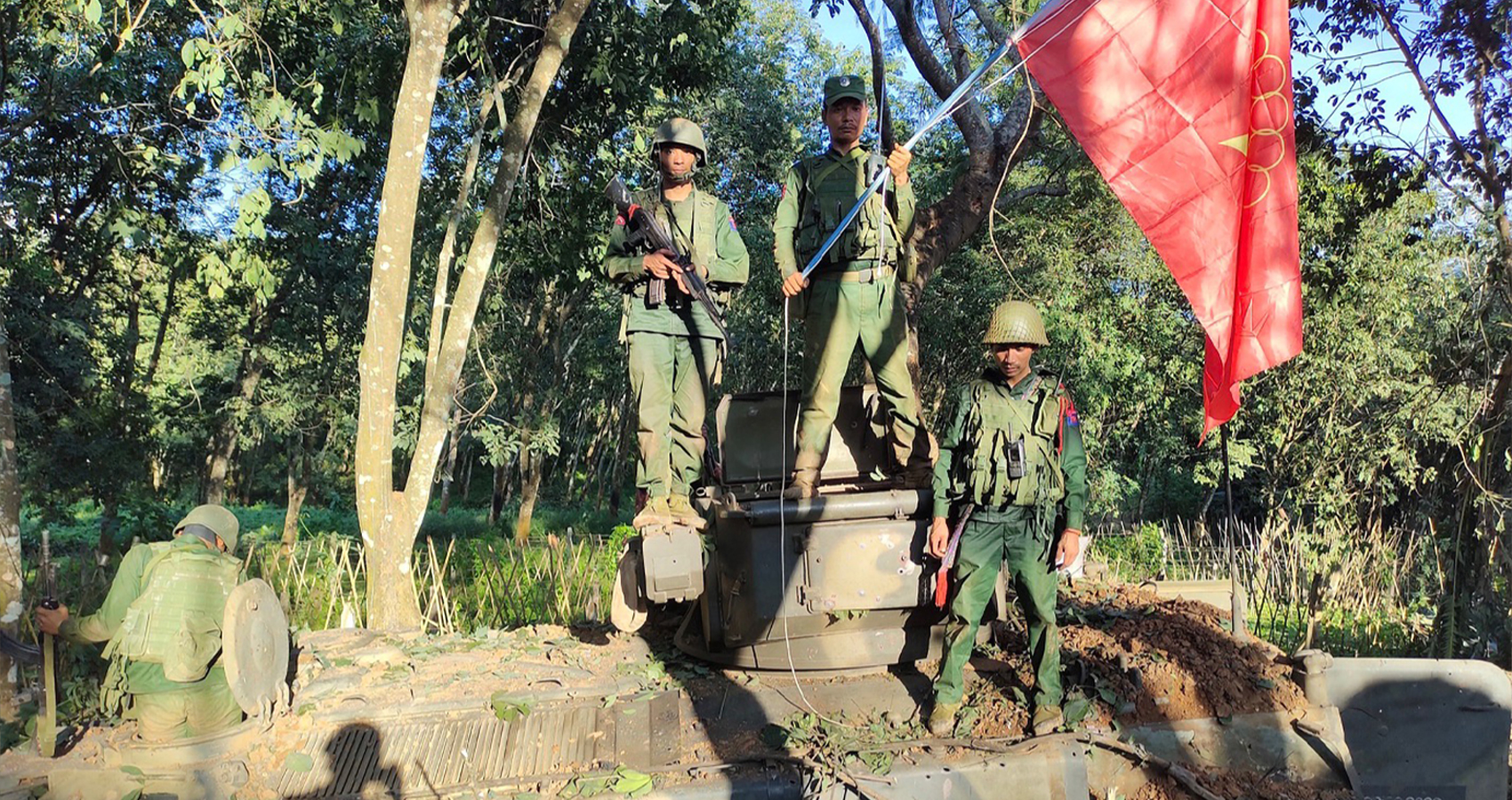MNDAA troops are seen after seizing a junta tank in a clash in northern Shan State during Operation 1027. / The Kokang The Irrawaddy
Ethnic Armies shock Tatmadaw
By: Nava Thakuria 28 November 2023
Myanmar, whose agony has slipped from the world’s front pages as violence in other regions has caught attention, has witnessed a flare-up as many armed ethnic groups have begun a massive offensive against the Burmese military junta starting in the last week of October, with the current conflict differing because ethnic armies are no longer on the defensive perhaps for the first time.
By now, some parts of the nation have come under the control of pro-democracy
Amazingly, public demonstrators in Yangon recently dared retribution to chant slogans against China, a major source of arms and other support to the junta, assembling in front of the Chinese Embassy on November 19. The agitators, understood to be pro-junta, claimed that Beijing is behind the recent offensive against the military regime and is supporting the people’s defense forces (PDF), the armed wing of the National Unity Government. Speculation is now being raised that Beijing has had enough of the current batch of Burmese military dictators, who are enormously unpopular across the country.
The odds that the rebels could bring down the government are slim, however. Both Russia and China are supplying the Tatmadaw, or military, and as far as can be determined there is no major arms supplier to the rebels, who nonetheless have made major arms seizures from fleeing government troops. Singapore is also alleged by rebels to be a major arms supplier. No Western democracy has formally recognized the shadow National Unity Government as Myanmar’s legitimate government, although none has recognized the junta either.
The country had enjoyed some progress toward normality following the 2011 cession of some of the military’s power to civilian rule and the creation of a semi-democratic government under the 2008 constitution. More than 27 million Burmese of a population of 55 million participated in November 2020 polls that humiliated the junta, with NLD nominees winning more than 920 of 1,117 available constituencies. The military-supported Union Solidarity and Development Party (USDP) succeeded in only 71 seats.
The junta alleged vote fraud although domestic and international observers found the polling to be free and fair, ousting the democratically elected government under the leadership of Nobel peace laureate Daw Aung San Suu Kyi and the National League for Democracy (NLD) in February 2021. The country slipped into conflict soon after the military, led by Min Aung Hlaing, the chairman of the State Administration Council, took over.
When outraged citizens responded with huge rallies, banging pots and pans to signal their displeasure, the military responded with overwhelming force. Suu Kyi was detained and later imprisoned by the military-controlled courts for many years on trumped-up charges alleging her involvement in electoral corruption. Along with Suu Kyi, who had functioned as state counselor in the previous government, President U Win Myint and many NLD officials and elected ministers were booked as well.
Some 141 elected NLD lawmakers, both in parliament and various states, and more than 1,900 NLD activists were arrested after the coup, with half of them still behind bars. Many elected representatives fled the country and at least 18 have died of illnesses from inadequate medical care during the days in hiding. The military rulers seized properties belonging to 182 elected representatives. The junta shocked the world by executing former lawmaker Ko Phyo Zeya Thaw following trials in the military courts.
According to Progressive Voice, a participatory rights-based policy research and advocacy organization, at least 2,940 civilians were killed by the military authorities
A recent statement issued by the United Nations High Commissioner for Refugees revealed that more than 333,000 civilians have been rendered homeless in the ongoing fighting between the junta forces and ethnic armed organizations along with the people’s defense force (PDF). More than two million have been displaced across the country since the last military takeover.
The recent wave of fighting broke out on October 27, when three ethnic minority groups, the Myanmar National Democratic Alliance Army (MNDAA), Ta’ang National Liberation Army (TNLA), and Arakan Army (AA) coordinated an offensive in the northern Shan locality, which is adjacent to China. Named ‘Operation 1027’, the offensive had cost the Tatmadaw nearly 200 military camps and nine towns by the third week of November. The AA rebels recently launched an offensive in Rakhine State, many junta soldiers and even forcing some to surrender with arms and ammunition.
A Burmese political activist who asked to remain nameless told Asia Sentinel the Rakhine region has
The UN Office of Humanitarian Affairs recently stated that the fresh clashes in Rakhine localities displaced over 26,000 people. The AA forces continue to press demands for the restoration of democracy with a collective desire to safeguard the lives of civilians, assert rights for self-defense, and maintain territorial integrity. The UN office asked that individual soldiers be treated with humanity when they are captured.
The troubles in various western Myanmar localities have increased the influx of refugees into Mizoram in northeast India. Even many Burmese soldiers have deserted, crossing the porous boundary to arrive in the state but were later sent back by the Indian agencies. The government in Aizawl has extended necessary support to the refugees. The hilly state is now giving shelter to thousands of Burmese asylum seekers, mostly Chin refugees, who enjoy ethnic proximity to Mizo people. Many of their children have enrolled in the government-run schools.
New Delhi has recently directed

